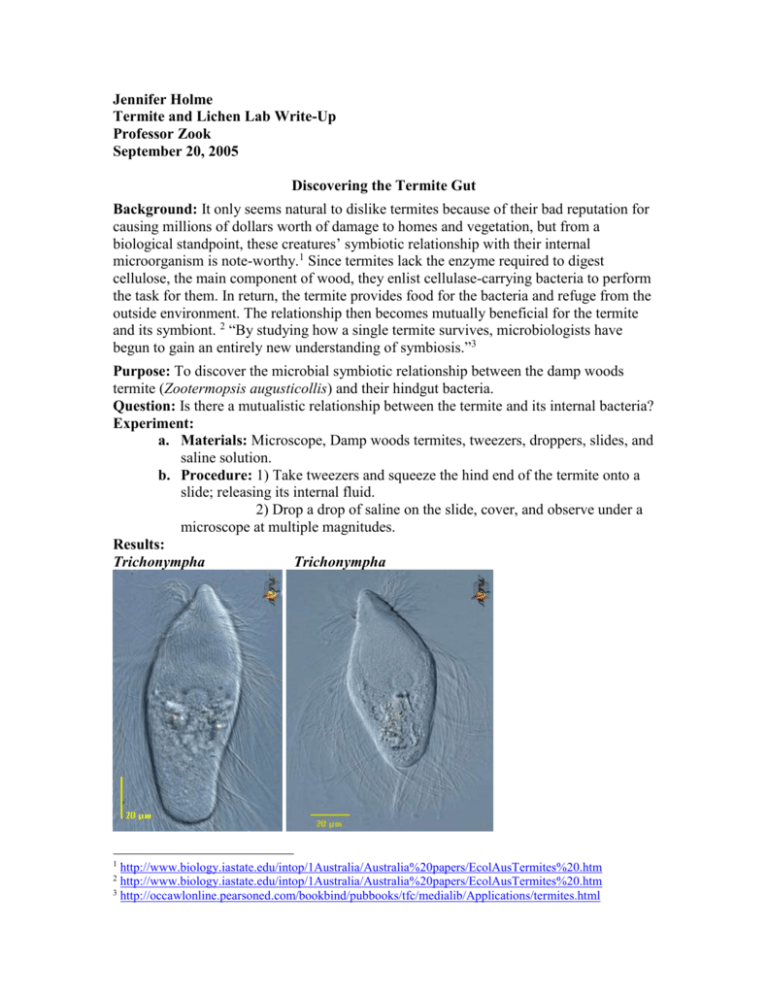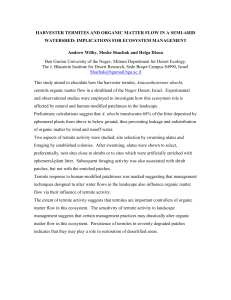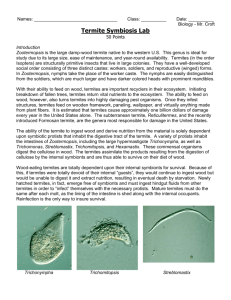Termite Lichen Lab
advertisement

Jennifer Holme Termite and Lichen Lab Write-Up Professor Zook September 20, 2005 Discovering the Termite Gut Background: It only seems natural to dislike termites because of their bad reputation for causing millions of dollars worth of damage to homes and vegetation, but from a biological standpoint, these creatures’ symbiotic relationship with their internal microorganism is note-worthy.1 Since termites lack the enzyme required to digest cellulose, the main component of wood, they enlist cellulase-carrying bacteria to perform the task for them. In return, the termite provides food for the bacteria and refuge from the outside environment. The relationship then becomes mutually beneficial for the termite and its symbiont. 2 “By studying how a single termite survives, microbiologists have begun to gain an entirely new understanding of symbiosis.”3 Purpose: To discover the microbial symbiotic relationship between the damp woods termite (Zootermopsis augusticollis) and their hindgut bacteria. Question: Is there a mutualistic relationship between the termite and its internal bacteria? Experiment: a. Materials: Microscope, Damp woods termites, tweezers, droppers, slides, and saline solution. b. Procedure: 1) Take tweezers and squeeze the hind end of the termite onto a slide; releasing its internal fluid. 2) Drop a drop of saline on the slide, cover, and observe under a microscope at multiple magnitudes. Results: Trichonympha Trichonympha 1 http://www.biology.iastate.edu/intop/1Australia/Australia%20papers/EcolAusTermites%20.htm http://www.biology.iastate.edu/intop/1Australia/Australia%20papers/EcolAusTermites%20.htm 3 http://occawlonline.pearsoned.com/bookbind/pubbooks/tfc/medialib/Applications/termites.html 2 There were multiple floating bacteria pushing each other around trying to move closer to the food. Their undulipodia helped them move to the wood particles in the gut or pauch of the termite. Trichonympha (trick-owe-nymph-a) is one of the hypermastigid flagellates - flagellates with large numbers of flagella. They and the trichomonads made up the group called the parabasalids almost all of which are endobiotic or parasitic. There is an anterior symmetrical rostrum, and the numerous flagella arise from this region and from the region of the body immediately behind. There are also spirochaetes attached to the back of the body. The nucleus is a large structure lying some distance behind this. Cytoskeletal fibres with associated dictyosomes form bands running from the points of flagellar insertion through the anterior part of the body. Food vacuoles with particles of wood are found in the posterior part of the body. From the termite Reticulotermes. Trichonympha This is an optical section across the top of the rostrum and the adjacent part of the cell showing the cytoskeletal ribbons with which are associated the dictyosomes. Spirochaetes are motile bacteria. They have very fine flagella attached to the cell surface, and the rotating action of these propel spirochaetes through the medium. Spirochaetes have a spiral body and twist through the medium. Several different sized-spirochaetes can be seen in this image. From the termite Incisitermes. Very common inhabitants of the gut http://microscope.mbl.edu/scripts/microscope.php?func=imgDetail&imageID=871 http://user.uni-frankfurt.de/~schauder/termites/termites.html Protozoa from the hindgut of a termite Lower termites can be described as a set of 6 families sharing the presence of symbiotic intestinal flagellates. Higher termites are further evolved than lower termites in that they have lost the flagellate protozoa and replaced them with bacteria. Conclusion Questions: 1. What are the bacteria doing inside the termite? Termites ingest wood or plant material, which is made up mostly of cellulose. “The symbiotic gut protists (lower termites) or bacteria (higher termites) metabolize cellulose for the termites.” 4 The protists or bacteria are necessary in the metabolization of the cellulose, because termites do not natural have cellulase, the enzyme required for the digestion the cellulose. Without the bacteria or protist, the termite would not survive. 2. How does the bacteria survive metabolically? The protists depend on spirochete bacteria for survival. Bacteria attach themselves to the protist and continuously propel it forward, keeping the protist from falling out of the termite. 5 3. Why would the termite “tolerate” these masses of organisms? Termites acquire glucose and other materials produced from the metabolism of cellulose so they tolerate the bacteria in order to obtain these nutrients. Termites cannot digest cellulose without the symbiotic relationship between them and the protist or bacteria. 4. What could be the selective advantages for the inhabitants? If a particular protist or bacteria was able to move faster it would be able to get to the wood particles faster or if it was able to break down wood faster it would metabolize the cellulose faster for the termite. It is all about survival of the fittest. The faster and stronger will have an selective advantage over the competition. 5. How many kingdoms might be represented in this relationship? The general taxonomy of termites is Kingdom Animalia, Phylum Arthropoda, Class Insecta, and Order Isoptera.6 The symbiotic relationship is comprised of 3 Kingdoms: the Animalia representing the termite, the Plantae representing the wood, and the Protista representing the bacteria. 6. How might the microbes pass from one generation of termite to the next? The bacteria is passed from parent to offspring by regurgitation of food orally or by defecation anally. 7. What significance is the termite community to the earth? 4 http://www.biology.iastate.edu/intop/1Australia/Australia%20papers/EcolAusTermites%20.htm http://www.biology.iastate.edu/intop/1Australia/Australia%20papers/EcolAusTermites%20.htm 6 http://www.biology.iastate.edu/intop/1Australia/Australia%20papers/EcolAusTermites%20.htm 5 a. Without them there would be piles of dead wood covering forest floors, which could increase bacteria production and or forest fires. b. Termites are the most important decomposers in dry environments because of their ability to recycle nutrients, form soil, and retain moisture.7 c. Termite symbiotic relationships with bacteria have been studied for their similarities with human’s relationship with its internal bacteria. According to Margulis, “the same fast-swimming spirochete bacteria that keep Mixotricha paradoxa from falling out of the termite may also have played a role, for example, in the development of motility in human sperm cells, when long ago symbiotic mergers between the bacteria and the sperm cells created the tail that propels the sperm through the reproductive tract.”8 d. Scientist have hypothesized that pathogens have played important selections forces that “favored the evolution of complex insect societies” and this has been studied by “focusing on the adaptations that termites have evolved in order to resist disease.”9 8. Definition of Symbiosis: One living in the other in order to help it. Questions: 1. How do the termites harvest the fungus? 2. How do bacteria inside termites fix nitrogen? 3. Why do the bacteria ferment CO2,ethanol, and acetic acid? To break down the cellulose, termites enlist the help of a variety of microorganisms. Some termites, for example, dig tunnels in the wood, then inoculate the tunnels with fungi that grow on the wood. These termites then eat the fungi, not the wood itself. What microbiologists find more interesting are the termites that contain, within their digestive tracts, symbiotic microorganisms that digest the cellulose that the termites chew and swallow. Even more fascinating to microbiologists is the fact that these microorganisms themselves can survive only because of even smaller symbionts that live on and within them, without which they would not even be able to move. The termite's dependence on nitrogen-fixing bacteria to supply its nitrogen and on protozoans such as Trichonympha sphaerica to digest cellulose is an example of endosymbiosis, a symbiotic relationship with an organism that lives inside the body of the host organism (in this case, within the hindgut of the termite). Theoretically, the protozoan produces the cellulolytic enzymes that digest the cellulose. The picture is more complicated than this, however, for T. sphaerica itself is unable to digest cellulose with out the aid of bacteria that live within its body; in other words, the protozoan has its own endosymbionts. Certain hindgut ciliates such as T. sphaerica also demonstrate another form of sybiosisectosymbiosis, a symbiotic relationship with organisms that live outside its body. Recent 7 http://www.biology.iastate.edu/intop/1Australia/Australia%20papers/EcolAusTermites%20.htm http://inpress.lib.uiowa.edu/poroi/papers/lopez010101.html 9 http://occawlonline.pearsoned.com/bookbind/pubbooks/tfc/medialib/Applications/termites.html 8 advances in microscopy have shown that these ciliates are covered by precise rows consisting of thousands of bacteria, either rods or spirochetes. If these bacteria are killed, the protozoan in unable to move. Evidently, the protozoan does not use its cilia to move; instead, the rows of bacteria move the protozoan like rows of bacteria move the protozoan like rows of oarsmen in a boat. http://occawlonline.pearsoned.com/bookbind/pubbooks/tfc/medialib/Applications/termites.html





